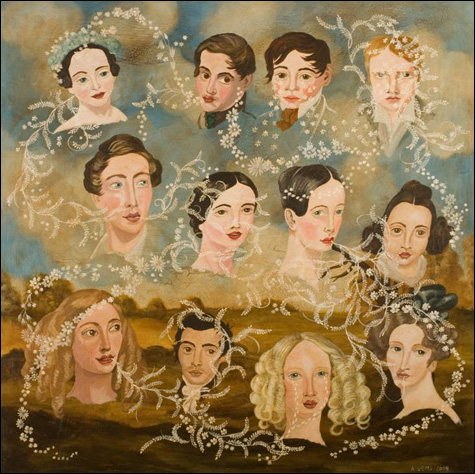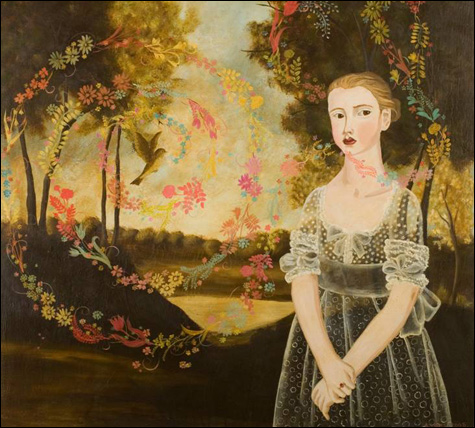
FACES Siems transforms disparate influences into something fresh — like the ravishing moments from a Brontë sisters novel. |
| “Anne Siems” | Walker Contemporary, 450 Harrison Ave, Boston | Through July 31 |
Anne Siems's paintings are time machines teleporting you back to the early days of our American republic. In her show at Walker Contemporary, the German-born, Seattle-based artist channels the endearing awkwardness of artists like John Brewster Jr., who roamed New England at the start of the 19th century painting portraits. She mixes in early American stenciled wall decorations and designs that young girls embroidered into samplers. She sets it all atop dreamy soft-focus landscapes rendered with a golden brown patina that makes the paintings look antique. The combination transforms these influences from just a pastiche into something that feels fresh and sweeps you up like ravishing moments from a Brontë sisters novel.Faces (2008) lines up three rows of heads — rosy-cheeked fellows with shaggy neo-classical hair and ladies with pre-Civil-War-style cascading ringlets — floating before an ochre field and cloudy blue sky. White foliage swirls from their eyes like tears, or from their mouths like gossip. Conversation (2008) shows a blonde woman in a transparent dress (a ghost? a dream?) through which you can see hills, spindly trees, and a pond behind her. Patterns of flowers and leaves spiral from her mouth and encircle a hovering, smiling bird.
 |
Siems is part of a vast group of artists who have adopted "folk" or "outsider" or "vernacular" styles. Local examples include folksy surreal portraits and still-lifes painted by Jane Smaldone of Roslindale and Art Nouveau flowers, chandeliers, and constellations drawn by Mary O'Malley of Somerville. Or check out Julia Fernandez-Pol's paintings, which resemble hothouse flowers or tropical fish made of icing atop fabulous birthday cakes, in the group show "Dis-Cordances/Dis-Representations" at G.A.S.P. (362 Boylston St, Brookline) through July 20. The New York-based, Venezuelan-born, Boston University grad gets this look by squeezing out lines of paint with cake decorating tools and scalloping thick dollops with knives.
All of this comes as a belated reaction to fine art's ascetic aesthetic cul-de-sac of the 1970s, when Minimalism and Conceptualism reached the logical conclusion of Modernist's drive to break art down to its fundamental atomic elements. Subsequent Post-Modernism of the '70s and '80s sampled the past in shuffle mode as it questioned the nature of authenticity. But many artists simply craved that authenticity. So they did what Modern artists have done since Gauguin posed as a Tahitian naïf, Picasso borrowed from African masks, Jackson Pollock fancied himself a Native American shaman, and Pop artists ripped off comic books — they mined art outside the precincts of "fine" art for its raw energy.
The DeCordova Sculpture Park and Museum's current show, "The Old, Weird America," surveys folk themes and styles in contemporary conceptual art. The popularity of deadpan photography these days partly reflects the influence of "vernacular" photography like amateur snapshots or the small-town, Depression-era studio portraits by Mike Disfarmer. But the wildcat energy of folk art has been retransmitted with the least loss of voltage by painting and drawing. Painting and drawing are the primary media of folk art itself, and most easily reproduce its messy, vigorous, gloriously flawed, handmade humanity. As we struggle to come to grips with the proliferation of technology in our lives, the humanness of the folk revival can feel like an oasis.
Read Greg Cook's blog at gregcookland.com/journal.